USDOT Thriving Communities Program: Indianapolis, IN
15 minutes Date Launched/Enacted: May 20, 2025 Date Published: May 20, 2025
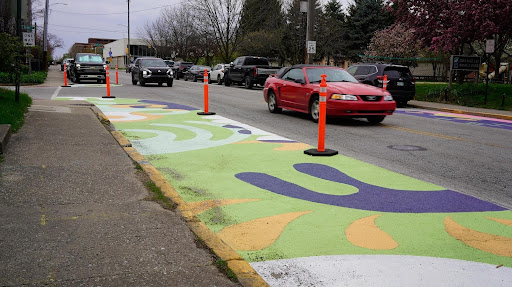
About the Thriving Communities Program (TCP)
The Thriving Communities Program (TCP) funds tailored technical assistance to under-resourced and disadvantaged communities, helping them better access historic infrastructure investments and deliver transformative projects. The USDOT FY 2022 Thriving Communities Program supports 64 communities across the country with access to a team of capacity builders to develop innovative community engagement methods, identify funding opportunities, and grow long-term capacity to develop and deliver transportation projects that strengthen communities.
TCP Complete Neighborhoods Community of Practice
TCP Communities are grouped into three Communities of Practice: Main Streets, Networked Communities, and Complete Neighborhoods. The 15 communities included under the Complete Neighborhoods Community of Practice are:
| Atlantic Beach, SC | Isabela, PR | Santa Cruz, CA |
| Billings, MT | Lansing, MI | St. Louis County, MO |
| Decatur, IL | Lima, OH | Suffolk, NY |
| East Orange, NJ | Providence, RI | Sumter, SC |
| Indianapolis, IN | Roanoke, VA | Waukegan, IL |
The US Department of Transportation (USDOT) selected a capacity building team led by RMI, including: the American Council for Energy-Efficient Economy (ACEEE), Equitable Cities, Nelson\Nygaard, and the Shared-Use Mobility Center (SUMC), to provide technical assistance to these 15 communities.

A Snapshot of Indianapolis, Indiana
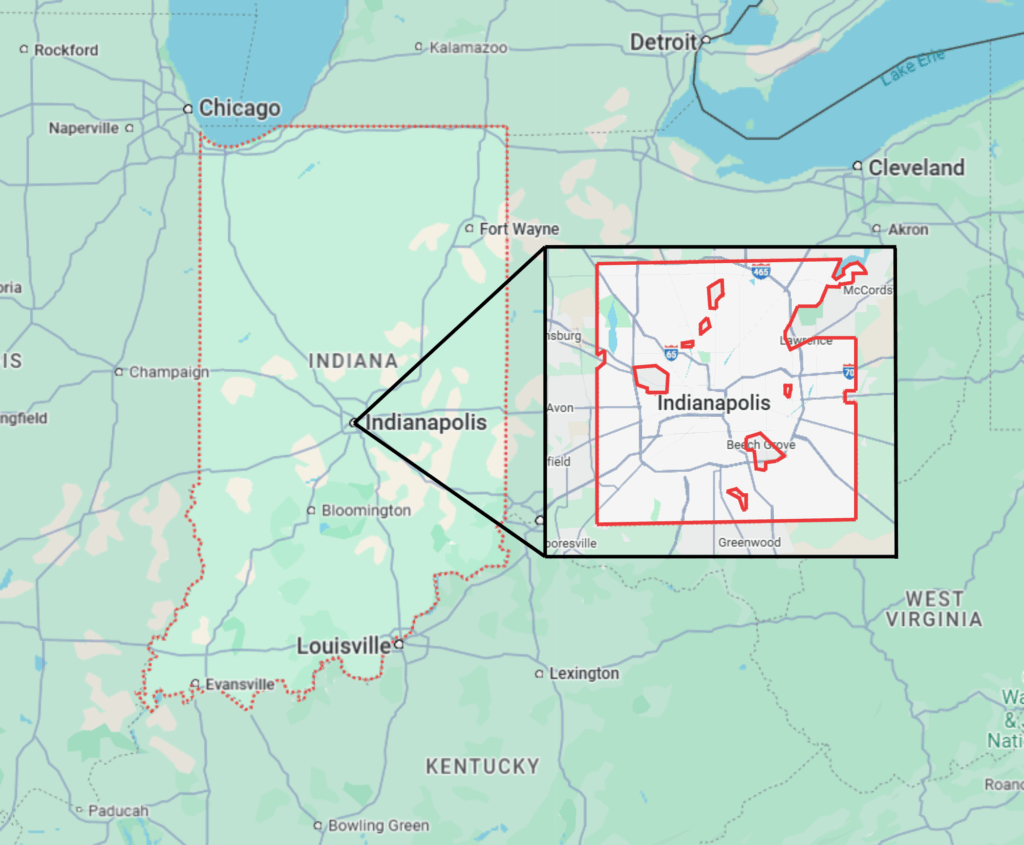
Location of Indianapolis within Indiana. Credit: Google Maps
Indianapolis is Indiana’s capital and most populous city, with a population of 879,293 people, and a metropolitan area population of roughly 2.1 million residents, according to the 2024 US Census. Located in central Indiana, it is the seat of Marion County. The state’s motto, the “Crossroads of America,” and Indianapolis’s nickname as the “Railroad City” reflect the historical ties to transportation. However, Indianapolis lacks a robust public transportation system and has very limited regional transportation options. Getting around without a car is difficult and poses intense safety risks due to lackluster pedestrian and biking infrastructure, and wide roads made for quick vehicular travel. Nevertheless, the city has been working on creating pedestrian-friendly improvements through tactical urbanism across a variety of priority intersections. Initial efforts have been successful, and the city hopes to expand tactical urbanism programming so that the neighborhood initiatives can also stem from grassroots efforts.
As with many midwestern cities across the country, Indianapolis is grappling with the result of decades-long disinvestment in the city center, which has left a lack of blue-collar jobs and transportation infrastructure that best serves people going in and out of the city from the surrounding suburbs. The metro area is rapidly growing and creating jobs that cannot be filled due to a lack of labor force with the means to reach these job centers. Indianapolis also has the state’s highest concentration of citizens re-entering the labor force after incarceration and the largest population of individuals experiencing homelessness, which emphasizes the need for multimodal transportation for those who may not have vehicles. The work through TCP is focused on the Indy East Promise Zone, an area recognized by the federal government as a priority area due to historic disinvestment and neglect. Within that area, Sherman Drive serves as an industrial thoroughfare supporting economic development activity, and connecting Sherman Park, a 50-acre brownfield redevelopment site, to the Community Justice Campus (CJC), a newly redeveloped 140+ acre brownfield site. Using Sherman Drive as a pilot location, the Indianapolis team is hoping to demonstrate the power of tactical urbanism in addressing some of the safety and accessibility concerns along major streets. The primary goal of technical assistance is to transform Sherman Drive into a safe, accessible corridor that supports multi-modal transportation and serves the needs of those who live and work in the Indy East Promise Zone.
Key Initiatives for Transportation
The Capacity Builder team, led by Equitable Cities, worked with the Indianapolis team to identify major goals to be advanced through Thriving Communities Program support.
Transportation Data Collection
The Indianapolis team wanted detailed information specific to Sherman Drive, to contextualize the study area within broader city data and develop a list of priorities for the community. Using existing data and additional qualitative data, Equitable Cities compiled maps and aided in the prioritization of community outreach partners, to guide potential partnerships for multimodal transportation efforts in the area. In addition, the stakeholder mapping exercises facilitated by Equitable Cities served as the basis for determining priority organizations to engage and include as the work continued.
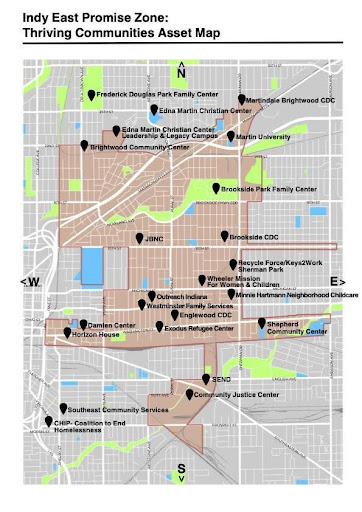
Community Assets in the Indy East Promise Zone. Credit: City of Indianapolis.
Leverage Indianapolis’ Tactical Urbanism Program
Indianapolis’ Department of Public Works (DPW) has been increasingly working on tactical urbanism across the city as a way to demonstrate the potential of future, permanent multimodal infrastructural changes. Due to the successes and excitement growing around initial projects, the DPW decided to craft a program called Community Powered Infrastructure (CPI), which allows residents to apply for materials, attain some funds, and get DPW support to install tactical urbanism in their neighborhoods. Despite initial efforts to engage the community about the program, the outreach about CPI was not very effective at engaging the harder to reach neighborhoods. As the Indy team consists of representatives from a variety of offices, the Mayor’s Office representatives noted that their Mayor’s Neighborhood Advocates, who serve as community liaisons between Indianapolis’ neighborhood residents and the mayor’s office, could serve as the ideal interlocutors for this program. Thus, the Indianapolis team asked Equitable Cities to develop public engagement workshops to guide these liaisons on how to engage their fellow residents about the CPI program in an exciting and accessible manner.
The team decided to use the direct support funding to further elevate these efforts by buying materials to implement pilot projects along the Sherman Drive corridor. The tactical urbanism demonstration pilot project sites were selected based on transportation safety data and input from the community leads on the Indy team. These intersections are already on the roster for permanent safety improvements, so the pilot tactical urbanism installation will demonstrate the potential of the upcoming changes.
Key Partners
Indianapolis is working with several key partners on these initiatives. Some of these partners include:
- RecycleForce – RecycleForce is an evidence-based provider of workforce development for returning citizens.
- John Boner Neighborhood Centers – The Centers lead the IndyEast Promize Zone and host a Center for Working Families, a community-based workforce development program. The Centers are a space for convening, partnering on outreach, and facilitation of community meetings.
- IndyEast Promise Zone – The Promise Zone Champions equitable redevelopment, convened 60+ orgs around issues of workforce development, safety, etc. The Promise Zone will support community engagement efforts, including collaboration with the capacity builders to identify avenues to engage the returning citizen community.
- Indy Arts Council – This non-profit is Central Indiana’s leading arts advocacy and services agency that works to champion arts and culture across Indianapolis’ metropolitan area.
These partners have overlapping community relationships that will allow them to serve as trusted convenors, connectors and outreach leads to key populations, and experts on workforce and transportation needs.
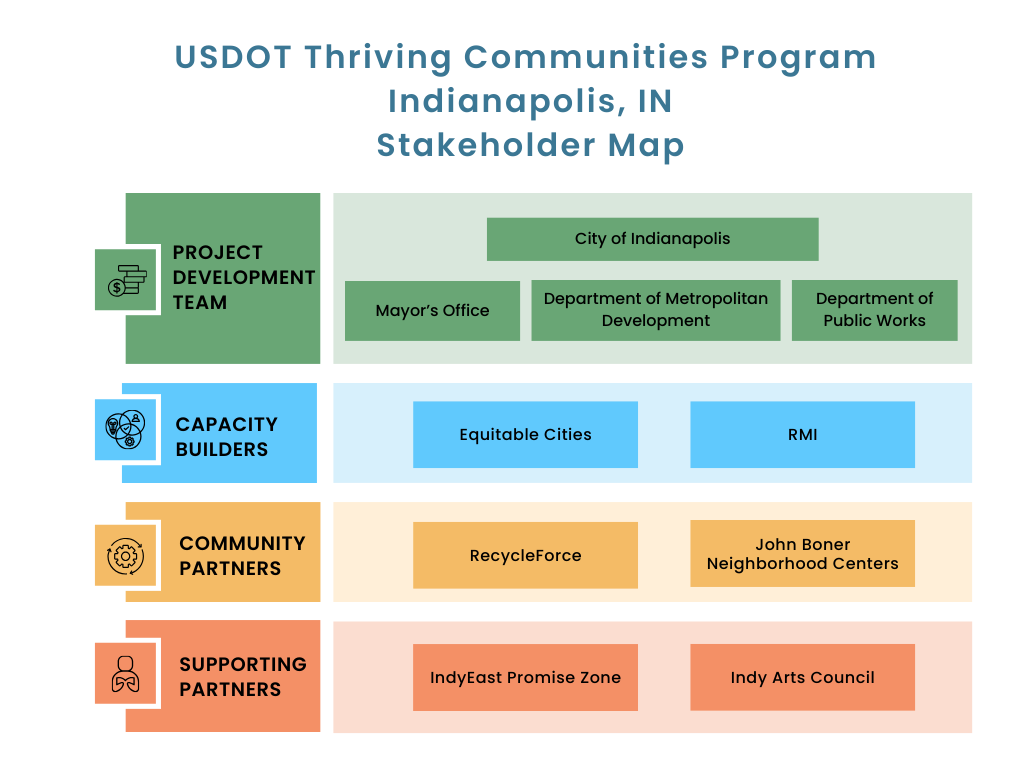
Stakeholder Map. Credit: SUMC
Activities through the Thriving Communities Program
Building upon the key initiatives identified by the Indianapolis team and the preliminary data collection, Equitable Cities focused its efforts on tactical urbanism engagement workshops, leveraging connections at site visits, and the tactical urbanism demonstration project on Sherman Drive.
Community Powered Infrastructure (CPI) Engagement Workshops
Equitable Cities prepared three CPI workshops for the Mayor’s Neighborhood Advocates (MNAs). The first centered around accessibility of the terms discussed in the CPI Program. Advocates were asked to define, in their own words, tactical urbanism, placemaking, and other key concepts of the CPI program. Through these exercises, the MNAs indicated how some concepts should be explained and framed to resonate with their particular neighborhoods. The second workshop focused on a detailed run through of the application process with a mock project to illustrate what a resident would have to prepare in order to have a strong application. Finally, the third and final workshop was centered around community concerns and answering difficult questions that arose around the topic of tactical urbanism. The MNAs were asked to create their own FAQ sheets and elevator pitches based on what they hear in their work engaging with residents across the city. Each workshop was crafted to have time for questions, breakout activities, and instruction, to balance the needs for input and education.
The discussions and feedback from these sessions informed the creation of an internship project to develop a CPI guide and influenced some of the deliverables that Equitable Cities provided Indianapolis to continue these efforts after the Thriving Communities Program has concluded. For example, based on concerns about each resident having to draft their own community engagement tools, Equitable Cities will provide a survey template that residents can use as they get started on their CPI projects’ community engagement, which will be housed on the CPI website and in the guide. The capacity builder team will also provide an evaluation packet of the CPI workshops, which will include the workshop agendas, slide decks, major workshop feedback, and a summary of notes for each workshop. The intention is that the Indianapolis team is able to replicate the workshops, as they indicated that they want to continue the initiative for new cohorts of the MNAs and across departments.
Site Visits
Site visits are an integral part of the USDOT Thriving Communities Program, as they allow for a deeper understanding of the local context. For the first site visit, in May of 2024, Equitable Cities toured the RecycleForce building, which highlighted the organization’s key role in the Indy East Promise Zone as an industrial employment center, by helping people recently released from prison to gain actionable skills for employment. As an electronics recycling plant, they use Sherman Drive to truck in materials and many of their employees walk, bike, or use the bus to get to work, which demonstrates the importance of multimodal modifications that cater to a wider variety of ways to move through that corridor. The Indianapolis team also took the capacity builders on a bus tour of the Indy East Promise Zone, to show the locations of key community stakeholders and illustrate the existing partnerships in this particular part of the city. The site visit concluded with a Sherman Park Advisory Board meeting, where the Indianapolis team and Equitable Cities introduced the Thriving Communities Program and brainstormed how it could elevate existing work of city officials and anchor institutions.
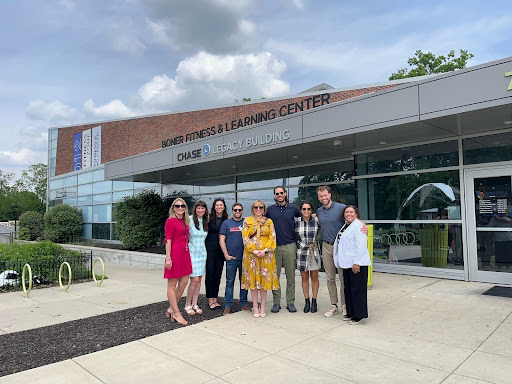
The Indianapolis team with Equitable Cities at the John Boner Fitness and Learning Center in the Indy East Promise Zone. Credit: City of Indianapolis
The second site visit was held in the spring of 2025, to take advantage of nicer weather to see tactical urbanism installed in the city. The John Boner Neighborhood Centers’ staff graciously hosted the full day event at one of their community spaces. The last of the three CPI workshops was held in person, where MNAs were able to work on their FAQs and elevator pitches together in teams. After the CPI workshop, the group travelled to a local food court to grab lunch, before returning to the venue to welcome council members, community benefit corporation representatives, and neighborhood advocates, for a presentation about the Thriving Communities Program’s work in Indianapolis and how local leaders can become involved as the capacity building support draws to a close. Participants were excited about the work and began to set up meetings in their respective districts to learn more about the CPI program. The day ended with a field trip to a tactical urbanism site that had just been installed in a nearby neighborhood, which will be emulated in the pilot projects along Sherman Drive. This final site visit served as a closing celebration of all the work that has been achieved in Indianapolis through the Thriving Communities Program.
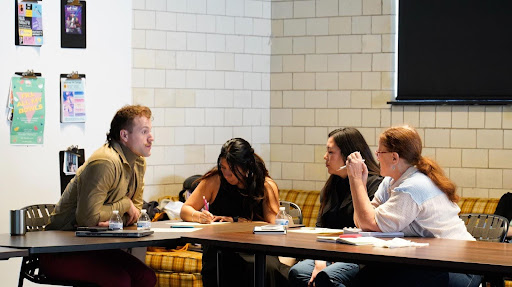
Mayor’s Neighborhood Advocates brainstorming their Community Powered Infrastructure pitch during the in-person workshop. Credit: Equitable Cities
Pilot Tactical Urbanism Demonstration Project
As part of the data analysis and due to the city’s upcoming permanent projects in the area, four intersections on Sherman Drive were chosen as the sites of tactical urbanism in the corridor. These installations will make use of the direct support funding through the Thriving Communities Program and serve as a demonstration of future permanent infrastructural improvements. These sites will include bollards, curb extensions, Zikla planters, and water barriers to reduce car speeds and make conditions safer for all modes of travel. Two of the sites will also include art, by updating a faded mural, and by adding street art, elevating efforts to make Indianapolis’s streets safer and more inviting. The Indianapolis team will be partnering with the Indy Arts Council, the city’s leading arts advocacy organization, to develop concepts and hire local artists. At the time of writing this case study, the pilot project has not yet been installed.
Conclusion
The USDOT Thriving Communities Program has provided Indianapolis the opportunity to advance goals of promoting a multimodal transportation transition through tactical urbanism. As the Indianapolis team consisted of representatives across departments and offices, the meetings with the capacity builders supported continued coordination and a multidisciplinary space for brainstorming on the action items to achieve program goals. Now the city has additional tools and data points to elevate tactical urbanism efforts, namely the Community Powered Infrastructure program and the Sherman Drive pilot demonstration projects, in ways that will resonate more deeply with the city’s residents. The capacity builder team provided the extra support needed to bring these wonderful ideas to fruition.
Related Resources
Capacity building efforts through the Thriving Communities Program are continuing through May 2025. The Capacity Builder team will conduct more technical assistance activities and will update this case study as the program progresses.